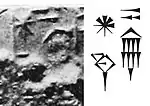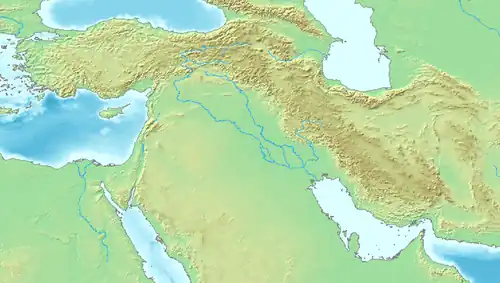| A-Imdugud 𒀀𒀭𒅎𒂂 | |
|---|---|
| King of Ur | |
 | |
| Reign | fl. circa 2600 BCE |
| Successor | Ur-Pabilsag |
| House | First Dynasty of Ur |
A-Imdugud (𒀀𒀭𒅎𒂂 ADIM.DUGUDMUŠEN, named after God Imdugud, also read Aja-Anzu),[1] was an early ruler of the First Dynasty of Ur in the 27th century BCE. He does not appear in the Sumerian King List, but is known from an inscribed seal found in tomb PG 1236 in the Royal Cemetery at Ur, which is the largest and probably the earliest tomb structure at the cemetery.[4]
Tomb
Several artefacts are known from tomb PG 1236, a twin tomb at the Royal Cemetery at Ur, although the tomb was robbed in the past.[5][6] Two inscribed seals were found, one is a banquet scene with an inscription Gan-Ekiga(k), and another with the depiction of a nude hero fighting lions and a war scene reminiscent of the Standard of Ur, with the name Aja-Anzu, also read A-Imdugud.[1] This seals is very similar to the seal of Mesannepada.[1] Gold leaves with embossed designs, as well as a reconstituted gold scepter, have also been found in the tomb.[7]
 The name "A-Imdugud" on the seal
The name "A-Imdugud" on the seal Plan of tomb PG 1236, with three chambers, thought to belong to A-Imdugud. Royal Cemetery of Ur.
Plan of tomb PG 1236, with three chambers, thought to belong to A-Imdugud. Royal Cemetery of Ur._(14581041347).jpg.webp) Tomb PG 1236, at the Royal Cemetery of Ur. Domed chambers seen from above, and robbers' hole.
Tomb PG 1236, at the Royal Cemetery of Ur. Domed chambers seen from above, and robbers' hole._(14765144594).jpg.webp) Tomb PG 1236, at the Royal Cemetery of Ur. Doorway, and domed tomb chambers seen from above.
Tomb PG 1236, at the Royal Cemetery of Ur. Doorway, and domed tomb chambers seen from above.
Artifacts
_PG_1236.jpg.webp) Banquet scene with an inscription Gan-Ekiga(k), PG 1236.[1]
Banquet scene with an inscription Gan-Ekiga(k), PG 1236.[1] Gold foil, tomb PG 1236
Gold foil, tomb PG 1236 Design embossed on the gold foil, tomb PG 1236, thought to belong to A-Imdugud, Royal Cemetery of Ur.[7]
Design embossed on the gold foil, tomb PG 1236, thought to belong to A-Imdugud, Royal Cemetery of Ur.[7].jpg.webp) Gold, carnelian and lapis-lazuli beads, tomb PG 1236
Gold, carnelian and lapis-lazuli beads, tomb PG 1236
Royal scepter
A gold scepter was also found in tomb PG 1236.[7]
.jpg.webp) Scepter, tomb PG 1236
Scepter, tomb PG 1236
See also
References
- 1 2 3 4 5 Orientalia: Vol. 73. Gregorian Biblical BookShop. p. 182.
- ↑ Hall, H. R. (Harry Reginald); Woolley, Leonard; Legrain, Leon (1900). Ur excavations. Trustees of the Two Museums by the aid of a grant from the Carnegie Corporation of New York. p. 340, item 54.
- ↑ Drawing in Reade, Julian (2001). "Assyrian King-Lists, the Royal Tombs of Ur, and Indus Origins". Journal of Near Eastern Studies. 60 (1): 19. doi:10.1086/468883. ISSN 0022-2968. JSTOR 545577. S2CID 161480780.
- ↑ Reade, Julian (2003). Art of the First Cities: The Third Millennium B.C. from the Mediterranean to the Indus. Metropolitan Museum of Art. pp. 94–96. ISBN 978-1-58839-043-1.
- ↑ Hall, H. R. (Harry Reginald); Woolley, Leonard; Legrain, Leon (1934). Ur excavations. Trustees of the Two Museums by the aid of a grant from the Carnegie Corporation of New York. p. Plaques 116, 117.
- ↑ Hamblin, William James. Warfare in the ancient Near East to 1600 BC: holy warriors at the dawn of history, p. 49. Taylor & Francis, 2006. ISBN 978-0-415-25588-2
- 1 2 3 Hall, H. R. (Harry Reginald); Woolley, Leonard; Legrain, Leon (1900). Ur excavations. [n.p.] Pub. for the Trustees of the Two Museums by the aid of a grant from the Carnegie Corporation of New York. pp. 111–113.
Sources
- Jane McIntosh: Ancient Mesopotamia. ABC-CLIO 2005, ISBN 1-57607-965-1, p. 73 (restricted online version (google books))
- Leonard Woolley: The Sumerians. p. 38 (restricted online version (google books))

